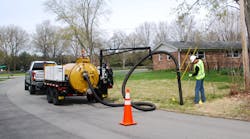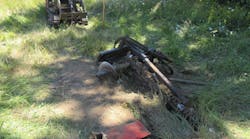Laboring in a remote, heavily wooded area, construction crews recently replaced half of a badly leaking wood stave penstock serving Public Service of New Hampshire's (PSNH) Jackman Station, an 80-year-old, hydroelectric generating plant in Hillsborough.
JML Trucking and Excavating of Errol, N.H., was the installation subcontractor for general contractor CCB Inc. of Westbrook, Maine, on the construction of 2,400 feet of 7-foot-diameter HOBAS CCFRPM fiber-reinforced pipe. The FRP pipe replaces the downstream section of an aging 5,000-foot wood stave penstock extending from the Franklin Pierce Reservoir to a surge tank upstream of the 3.2-megawatt hydroelectric facility.
According to Kleinschmidt Associates, a Pittsfield, Maine, consulting firm retained by PSNH to study the leakage problem, the existing 7.5-foot-diameter penstock was made up of 1970s, 1954, and original 1926 vintage wood stave sections.
Although repairs had been made over the years, the wood penstock still leaked badly. This leakage caused icing problems during winter months and required constant maintenance. In 2003, the penstock had a significant rupture that impacted abutting properties. To prevent future failures and ensure reliable operations of the hydro facility, a series of contracts were let by PSNH to replace the remaining wood stave penstock with a new pipeline.
Comparing OptionsKleinschmidt evaluated five pipe material options for the penstock replacement: wood stave, concrete, HDPE plastic, steel, and fiber reinforced polymer (FRP). The latter is a composite of fiberglass and resin extended with sand that provides a stable thick-walled and corrosion resistant pipe weighing less than other thick-walled alternatives.
The firm's evaluation showed FRP pipe provided a competitive advantage, offering corrosion resistance, lower relative material prices and a longer projected service life. It also has relative stiffness so that it could be supported on the existing grade and half buried, rather than placed on saddles or completely covered in a buried trench. Furthermore, according to Keith Martin, a project engineer and civil/structural engineer with Kleinschmidt, the lower frictional resistance of HOBAS compared to other materials allowed the replacement pipe to be reduced to a 7-foot diameter without additional head loss.
These features convinced PSNH to choose the FRP pipe, and the utility purchased CCFRPM pipe manufactured by HOBAS PIPE USA of Houston, Texas.
Remote SiteDuring installation, the pipe was half buried in the shallow trench of the existing penstock, requiring minimal excavation costs and low environmental disturbance. Approximately 300 feet of the new penstock was supported above ground on saddles to accommodate the topography as well as minimize the impact on wetlands.
The remote site presented a serious challenge for the contractors. On a 1,020-foot section inaccessible to delivery trucks, for example, crews had to unload the pipe at the side of the road and use a Hitachi excavator to carry individual lengths of pipe to the point of installation. The first part of the installation was on a bend where the individual lengths were connected and deflected incrementally to form the curve.
Watertight JointsThe HOBAS FWC coupling joint used on this project is a pressure joint commonly used in direct bury application and also for above-ground installations such as penstocks. According to the manufacturer, the joint is suitable for both non-pressure and pressure service up to 250 psi.
Attesting to the tightness of the joints, Newell Porter, CCB's project manager, said, "In our case, we air tested each joint after assembly with a 10-psi air test. None of the joints leaked. Once the line was in operation, we were required to visually inspect each and every joint for a sign of leakage and there was none," he said.
Kleinschmidt's Keith Martin remarked on the economy of using FRP pipe on the Jackman job:
"At the end of the project, it was found to be approximately seven times cheaper per foot to utilize the fiberglass pipe option partially backfilling the penstock than to support it above ground," he said, adding, "the hydraulic advantages and longevity of the line will also provide lifelong savings."
(Ed.: Information and photos for this article were provided by HOBAS PIPE USA.)




